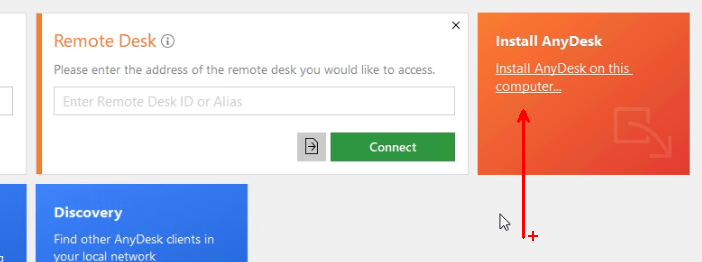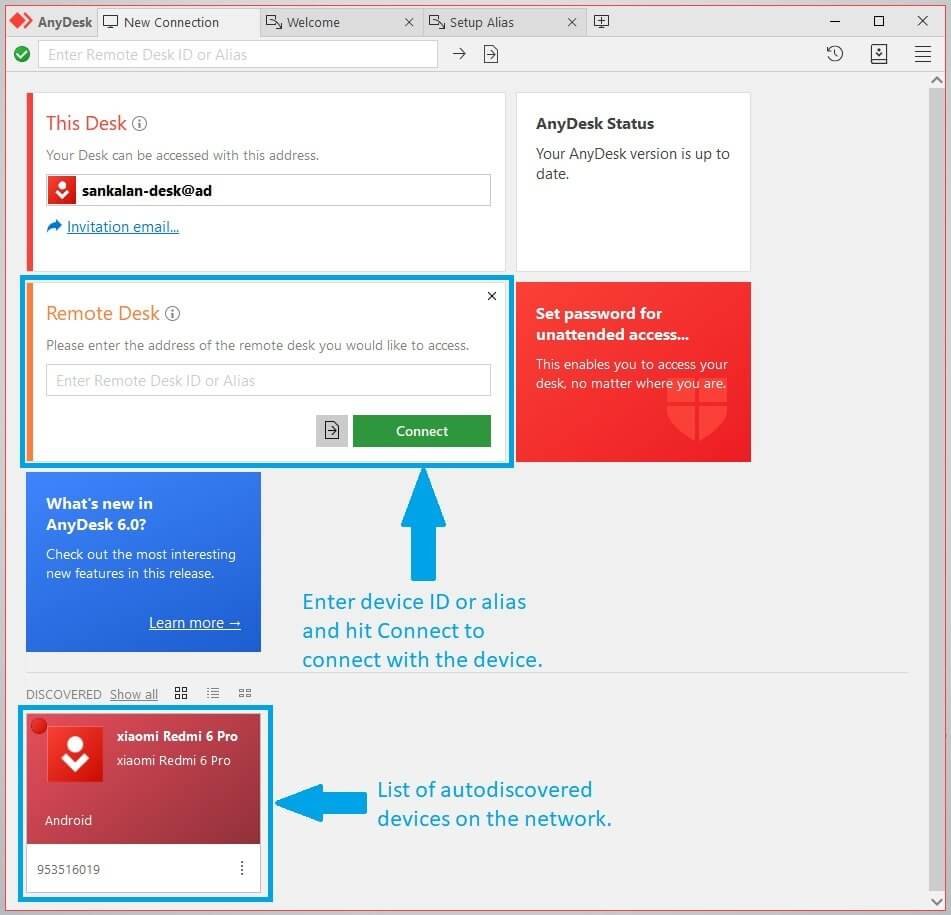Connect to a computer remotely, be it from the other end of the office or halfway around the world. AnyDesk ensures secure and reliable remote desktop connections for IT professionals and on-the-go individuals alike.
million sessions
per month
Like most hosted remote-access applications these days, AnyDesk connects out on ports TCP 80, TCP 443, and also one unique port – TCP 6568. Internally, it uses UDP ports 3 for multicasting to allow discovery on your local network. Using AnyDesk with managed Profiles (Work Profile) Steps to make the plugin AD1 ready for AnyDesk connections to a managed profile (Order is important) Make sure the plugin is installed in main profile and in managed profile. Make sure the plugin is activated in the accessibility settings. Open the plugin inside the main profile.
Outstanding Performance
Ever experienced our innovative DeskRT codec in action? Low Latency and high Framerates are critical for working remotely. Don’t wait for your remote desktop to respond - even at high screen resolutions or low bandwidths of just 100 kB/s.
Lean and Elegant

No administrative privileges or installation needed. Get started within seconds on any operating system. Work on the go with your mobile devices.
Superior Security
Security is our priority. We use military-grade TLS technology to ensure your device is protected from unauthorized access. RSA 2048 asymmetric encryption verifies every connection. For maximum reliability, our servers run on purpose-built Erlang telecommunication technology.
All Platforms

Like Anydesk
AnyDesk runs on all common operating systems and devices on the market without any additional charge. Apps for Windows, macOS, iOS, Android, Linux, Raspberry Pi and more.
In Cloud or On-Premises

AnyDesk offers maximum flexibility adapting to your security or policy requirements.
- Maintenance and updates included
- Independent global server infrastructure
- Reliable Service with 99%+ uptime
- Customized Clients available
On-Premises Solution
Suits businesses with individual security policies
- Customizable solution
- Advanced API integration options
- Self-hosted and self-managed by your IT Team
- Data remains within your company network
Still not convinced? Try it now!
Download NowNo signup required
Jan PetersCEO, Spidercam
'spidercam® Producer uses AnyDesk Remote Desktop Tool for Worldwide Equipment Support.'
Francisco RodríguezSoftware Like Anydesk
CIO, Airport Münster/Osnabrück
'It wasn't until we tried AnyDesk that we were able to solve the data security problem.'
Mario DioniesIT-Security Officer, AIP
'After searching for a bit, we found AnyDesk with its in-house-solution, offering exactly what we were looking for.'
By downloading and using AnyDesk, you accept our license agreement and our privacy statement.
Please consider taking our survey to help us make AnyDesk even better!
If the download does not start automatically, please click the Download link below.
 Get Started with AnyDesk in 3 steps:
Get Started with AnyDesk in 3 steps:Double-click the downloaded AnyDesk file and AnyDesk will start immediately.
Enter the ID or Alias of the remote device into the field under 'Remote Desk'.
Click the green 'Connect'-Button and enjoy our fast and simple remote software solution.
AnyDesk is a Remote Desktop solution which has become very popular in the last two years. It is overtaking TeamViewer in popularity because AnyDesk is currently a lot more generous with how much activity they allow on the free version. However, it is not always desirable to have remote access software such as AnyDesk running on your network. This article explains a number of measures to block AnyDesk from connecting out to the big wide world.
Ports used by AnyDesk
Like most hosted remote-access applications these days, AnyDesk connects out on ports TCP 80, TCP 443, and also one unique port – TCP 6568.
Internally, it uses UDP ports 50001-50003 for multicasting to allow discovery on your local network.
Anydesk Like Software
No special outbound rules or port forwarding are required to make AnyDesk work – so long as your network administrator hasn’t followed the below instructions to make life difficult for AnyDesk.
Anydesk Like App For Android
How to Block AnyDesk On Your Network
If you want to block AnyDesk on your network, there are a few measures you can put in place:
- Create local firewall rules using Windows Firewall to block outgoing connections from AnyDesk.exe
- Block the resolution of DNS records on the anydesk.com domain. If you run your own DNS server (such as an Active Directory server) then this is easy:
- Open your DNS Management Console
- Create a top-level record for ‘anydesk.com‘
- Do nothing else. By pointing this record nowhere you will stop connections to this domain and all of it’s subdomains
- Block anydesk.com in PiHole – this is another way to use DNS blocking to stop AnyDesk from connecting out via your network
- Ensure the only DNS connections allowed on your network are to your own internal DNS servers (which contain the above dummy-record). This removes the possibility of the AnyDesk client checking DNS records against their own servers, instead of yours. To do so, add a new outgoing firewall rule to disallow TCP & UDP port 53 from all source IP addresses, EXCEPT the addresses of your own DNS servers.
- You can utilise Group Policy to deny AnyDesk.exe from running. To do this, create a new Software Restriction Policy with a Hash Rule for AnyDesk.exe.
- If you have a firewall with Deep Packet Exception, you can enable the in-built rules to block AnyDesk. These firewalls often release new definition updates as the situation changes, so a lot of the hard work is handled for you.
- Block outgoing TCP Port 6568. You can create a DENY rule in your firewall to do this.
AnyDesk does not have any fixed IP addresses – they simply use IPs from cloud providers, and do not publish a list, so blocking IPs will be a game of whack-a-mole. However, these above seven steps should allow you to be successful in blocking AnyDesk from connecting out to the internet.
